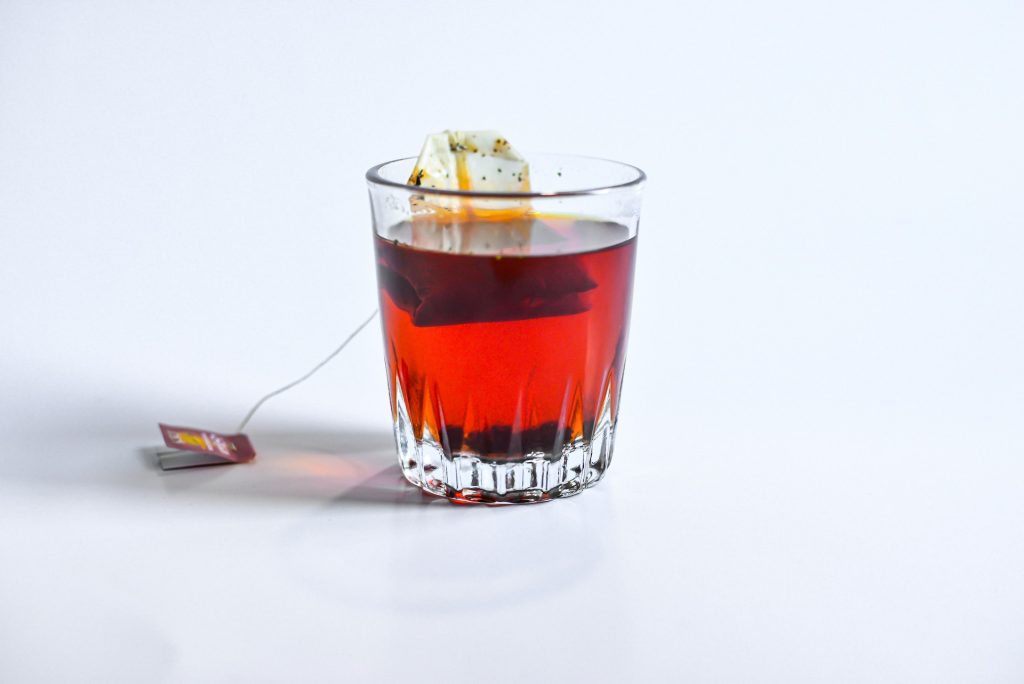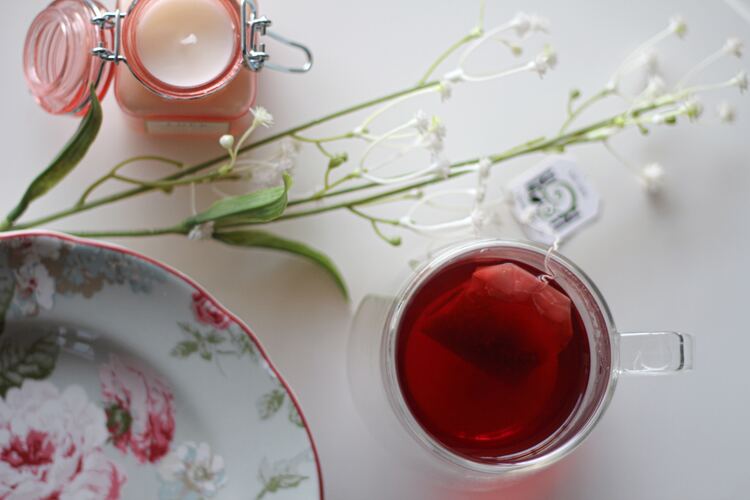If you’re a tea lover, you may have heard of red tea, also known as rooibos tea. It’s a popular beverage originating in South Africa and is now enjoyed worldwide. But what does red tea taste like?
We’ve tried red tea ourselves and can tell you that it has a distinctive flavor profile. Unlike black or green tea, red tea is naturally sweet and has a slightly nutty taste. Some people describe it as having a woody or earthy flavor, while others say it’s similar to honey or caramel.
Red tea is also caffeine-free, making it a great option for those who want to enjoy a warm, soothing beverage without the jitters or sleepless nights. It’s also packed with antioxidants and other beneficial compounds, making it a healthy choice for any time of day.
Keep reading to find more out about this tasty beverage!
Please note: This article contains affiliate links, meaning I may earn a commission if you make a purchase by clicking a link. Of course, this comes at no extra cost to you and helps me to keep offering solid information to readers.

What is Red Tea?
Rooibos tea, also known as red tea or African red bush tea, is a caffeine-free herbal tea that is made from the leaves of the Aspalathus linearis plant, which is native to the Cederberg region of South Africa.
Producing rooibos tea involves several steps, from harvesting the leaves to the final product. Here’s a general overview of the process:
- Harvesting: The process begins with carefully harvesting the rooibos plant’s young, needle-like leaves and stems. This is typically done by hand, as the plant is delicate and needs to be handled with care.
- Cutting and Chopping: After harvesting, the leaves and stems are usually cut or chopped into smaller pieces to facilitate the subsequent steps.
- Bruising: The cut leaves and stems are spread out in a thin layer and bruised or crushed to promote oxidation. This process is similar to the withering step in traditional tea processing. Oxidation is a crucial step contributing to developing rooibos tea’s characteristic flavor, color, and aroma. During oxidation, enzymes in the plant’s cells react with oxygen in the air, leading to chemical changes.
- Oxidation: The bruised rooibos leaves are left to ferment in the presence of oxygen for a specific period, usually around 8 to 24 hours.
- Heat Treatment: After fermentation, the oxidized rooibos leaves are subjected to heat treatment to halt oxidation. This step also serves to sterilize the leaves, ensuring they are safe for consumption. The heat treatment helps preserve the flavor and color of the tea.
- Drying: The heat-treated leaves are spread out and dried. Drying can be done using various methods, including sun drying, air drying, or specialized drying equipment. The goal is to reduce the moisture content of the leaves to prevent mold and bacterial growth while preserving the tea’s quality.
- Cutting and Grading: Once the leaves are fully dried, they are often cut or sifted to remove any remaining stems or coarse particles. The tea leaves are then graded based on size, quality, and appearance.
- Packaging: The final graded rooibos tea leaves are packaged into various forms, including loose-leaf tea or tea bags, ready for distribution and consumption.
Red tea can be enjoyed hot or cold and is often served with a touch of honey or milk to enhance its natural sweetness.
Note: In this article, we are concentrating on the beverage derived from the rooibos plant. However, the term red tea may refer to black tea (in various Asian languages it is called red tea, not black tea) or hibiscus tea.
What Does Red Tea Taste Like?
Red tea is a popular drink that has a unique flavor profile. In this section, we will explore the different taste notes that can be found in red tea.
Sweetness
Red tea has a natural sweetness that comes from the absence of bitterness. This sweetness is not overpowering, but it is enough to make the tea taste pleasant. If you prefer your tea to be sweeter, you can add honey or sugar to it.
Tartness
Red tea also has a slight tartness to it. This tartness is not as strong as the tartness found in black tea or green tea, but it is still noticeable. This note comes from the ascorbic acid found in the plant, the same acid found in citrus, tomatoes, and Brussels sprouts. This tartness can be balanced out by adding milk or cream to the tea.
Herbal Notes
Red tea has a distinct herbal flavor that comes from the plant itself. This flavor is not as strong as the flavor found in other herbal teas, but it is still noticeable. The herbal notes are earthy, woody, and slightly nutty. These notes are what give red tea its unique flavor profile.

How to Brew Red Tea
Brewing red tea is a straightforward process that allows you to enjoy its unique flavors and potential health benefits. Here’s a basic guide on how to brew rooibos tea:
Ingredients
- Red or rooibos tea leaves (about 1 to 2 teaspoons per cup)
- Freshly boiled water
Steps
- Boil Water: Start by boiling fresh water. Rooibos tea is often brewed at a higher temperature than other teas, so use water brought to a rolling boil.
- Preheat Teapot or Cup: Pour a small amount of boiling water into your teapot or cup to preheat it. This step helps maintain the optimal brewing temperature and prevent rapid cooling.
- Add Rooibos Tea: Measure 1 to 2 teaspoons of rooibos tea leaves for each cup of tea you plan to make. If you’re using a tea bag, use one tea bag per cup.
- Pour Hot Water: Pour the hot water over the rooibos tea leaves. The general guideline is to use about 8 to 10 ounces (240 to 300 ml) of water per cup.
- Steep Time: Allow the rooibos tea to steep. The steeping time for rooibos tea can vary based on personal preference and the strength of flavor you desire. A typical range is around 5 to 7 minutes. Longer steeping times may result in a stronger flavor.
- Optional Additions: Rooibos tea is naturally flavorful, but you can add optional ingredients to enhance its taste. For example, you might add a slice of lemon, a drizzle of honey, or a splash of milk (dairy or non-dairy) according to your taste preferences.
- Enjoy: Remove the tea leaves or tea bag after the steeping time. Your rooibos tea is ready to be enjoyed. Sip it slowly and savor its unique flavor and potential health benefits.
Tips
- Rooibos tea doesn’t become bitter with longer steeping times like traditional teas, so you can experiment with the steeping duration to find your preferred strength.
- Unlike traditional teas, rooibos tea is naturally caffeine-free, making it a great option for any time of day, including evenings.
- Rooibos tea can also be enjoyed as iced tea. Simply brew it as usual, let it cool, and then chill it in the refrigerator. You can add ice cubes and garnishes like lemon slices or fresh mint leaves.
- Store your rooibos tea leaves or tea bags in an airtight container to preserve freshness.
Remember that individual preferences can vary, so feel free to adjust the brewing method to suit your taste. Enjoy your cup of rooibos tea!
Health Benefits of Red Tea
Drinking red tea has many health benefits. Below, we discuss some:
Antioxidants
Red tea is packed with antioxidants that help protect our cells from damage caused by free radicals. These antioxidants include aspalathin and quercetin, which are known to have anti-inflammatory properties as well. As a result, drinking red tea regularly can help reduce the risk of chronic diseases such as cancer, heart disease, and diabetes.
Weight Loss
Red tea is also known to aid in weight loss. It contains compounds that can help boost metabolism and increase fat burning. In addition, red tea has been shown to reduce the absorption of dietary fat and carbohydrates, which can help prevent weight gain. Drinking red tea regularly can be a great addition to a healthy diet and exercise regimen for those looking to lose weight.
Reduced Inflammation
Chronic inflammation is linked to many health problems, including arthritis, heart disease, and certain cancers. Red tea contains anti-inflammatory compounds that can help reduce inflammation in the body.

Food Pairings
Red tea is a versatile beverage that can be enjoyed on its own or paired with various foods. Here are some of our favorite pairings:
- Fruit: Red tea’s fruity notes make it a great match for fresh fruit, such as berries, peaches, and apricots.
- Chocolate: The rich, earthy flavor of red tea pairs well with dark chocolate, creating a decadent and satisfying treat.
- Spicy Foods: The subtle sweetness of red tea can help balance out the heat of spicy foods, such as curries and chili.
- Cheese: Red tea’s complex flavor profile makes it a great match for various cheeses, from sharp cheddar to creamy brie.
When pairing red tea with food, it’s important to consider the intensity of the flavors. Lighter foods, such as salads and seafood, pair well with delicate teas, while heartier dishes, such as stews and roasts, can stand up to bolder teas.
Easy Recipes
Red tea is not only delicious but also versatile. Here are some easy recipes that you can try:
Red Tea Latte
If you love lattes, you’ll love this red tea version. Here’s how to make it:
- Brew a cup of red tea and let it cool down.
- Heat up some milk in a saucepan and froth it with a handheld frother or blender.
- Pour the frothed milk into the tea and stir.
- Add sweetener if desired.
Red Tea Smoothie
A red tea smoothie is a refreshing and healthy drink. Here’s what you need:
- 1 cup brewed red tea
- 1 banana
- 1/2 cup frozen berries
- 1/2 cup almond milk
- 1 tablespoon honey
Blend all the ingredients together until smooth and enjoy!
Red Tea Sorbet
A red tea sorbet is a perfect dessert for hot summer days. Here’s how to make it:
- Brew 2 cups of red tea and let it cool down.
- Add 1/2 cup of sugar and stir until dissolved.
- Pour the mixture into a container and freeze for at least 4 hours.
- Serve with fresh berries or mint leaves.
These easy recipes are just a few examples of how you can enjoy red tea. Feel free to experiment and create your own recipes!

Red Tea Buying Recommendations
Well, my friends, if you have not tried red tea, it is time to do it. Here are our top recommendations:


Twinings Pure Rooibos Red Herbal Tea

Organic Rooibos Loose Leaf Tea

Well, this is it! Hope you have enjoyed the article. Let me know your thoughts about red tea.
To you, what does red tea taste like?
More About Herbal Tea
What Does Mullein Tea Taste Like?
What Does Honeybush Tea Taste Like?
What Does Red Clover Tea Taste Like?
What Does Peppermint Tea Taste Like?
What Does Mint Tea Taste Like?
What Does Ginger Tea Taste Like?
What Does Lemon Balm Tea Taste Like?
What Does Chamomile Tea Taste Like?
What Does Raspberry Leaf Tea Taste Like?
What Does Mugwort Tea Taste Like?